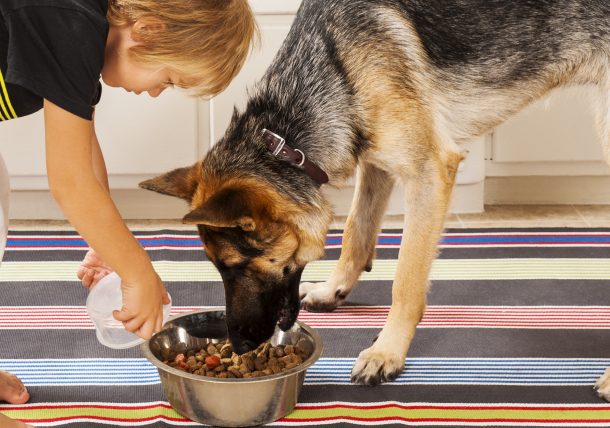Portioning Food for Dogs and Cats

Why Do We Need to Portion Food for Our Pets?
The prevalence of overweight and obese pets in the U.S. is on the rise. According to the Association for Pet Obesity Prevention, 60 percent of cats and 56 percent of dogs are overweight or obese. (1) While there are several health issues such as hypothyroidism that can lead to excessive weight gain due to changes in metabolism regardless of caloric intake, the most common cause of unnecessary weight gain in pets is overfeeding.
Does My Pet Require Caloric Control?
A paired feeding study conducted in 2002 established that dogs that were calorie restricted by 25 percent had overall lower body fat content, significantly longer life spans and delayed onset of clinical signs of chronic disease. (2) A similar study conducted in 2007 also determined that life-long appropriate caloric restriction (not leading to excessive weight loss or malnutrition) resulted in prolonged life and delayed onset of age-related diseases. (3) This means feeding less can result in saving money on dog food and veterinary bills and a pet who lives a longer, healthier life. Veterinarians recommend pets that are spayed or neutered have a 25- to 30-percent caloric restriction following spaying/neutering due to the decreased metabolic rate of “altered” pets. (4) Often this calorie restriction never occurs, resulting in the preconceived notion that “spaying or neutering makes a pet fat.” The truth is pets must be given a certain amount of food to remain at a healthy weight, and very few can be free-fed.
How Much Should I Feed My Pet?
While the feeding recommendations found on a bag or can of food are a good starting point, they are not always a hard-and-fast rule. Feeding guidelines on commercial “all life-stage” diets are commonly labeled for intact (un-neutered or un-spayed) young, active pets, resulting in excessive calorie intake for spayed/neutered, inactive house pets. One can use the feeding guide as a recommendation paired with body condition scoring (5) to help modify the feeding amount to attain the ideal weight for one’s pet. A veterinarian can help assign a body condition score to your pet along with teaching you how to evaluate this at home.
An easy at-home measure of body condition score is to feel for the ribs. If you can count them under a thin fat layer on the side of the chest, your pet is in a healthy weight class. If the ribs are lost, the pet may be at risk for weight-related diseases. In an already overweight pet, it’s recommended to reduce the amount of food fed by at least one third to one half to experience weight loss. This weight loss should occur gradually over a span of months; your pet didn’t gain weight overnight, and slow and consistent is preferred to a crash diet. Your veterinarian also can calculate your pet’s resting metabolic rate and create a custom feeding plan based on your preferred diet and individual goals for your pet.
Caloric Requirements Change Throughout Life
Throughout the life of our pets, we need to alter their feed intake to match their appropriate stage and activity level. Younger, growing pets will require more calories during the first one to two years of their lives. However, after growth is completed, they likely will need a decrease in feed to prevent excessive weight gain. Further decrease in caloric requirement is often necessary as our pets age with slowing metabolisms and generally less activity.
Don’t Forget Treats!
Anything that is fed to your pet such as treats, toys stuffed with peanut butter, etc., count as calories and must be added to your pet’s daily caloric total. Treats should not make up the majority of your pet’s caloric intake and only should be used as an occasional reward. Treats are extremely useful when given during training to reinforce appropriate behaviors or when giving a pet medication; however, too many treats can add on the pounds quite easily. Other options for treats can be using some of their normal daily ration of dry kibble as a “treat” or pet-safe vegetables (for those pets without gastrointestinal sensitivities) such as green beans, cucumber slices or carrots.
References
1. Association for Pet Obesity Prevention
2. Effects of diet restriction on life span and age-related changes in dogs
3. Metabonomic Investigations of Aging and Caloric Restriction in a Life-Long Dog Study
4. Canine and feline obesity: a one health perspective
5. Getting Your Dog in Shape
6. Dietary Aspects of Weight Management in Cats and Dogs
Ashley Navarrette, DVM, MS, MS, is a graduate of Texas A&M College of Veterinary Medicine who lives in College Station, Texas. Dr. Navarrette works at Texas A&M University, where she practices small animal emergency medicine.


I
I have a 6 /O female JRT. He said she weight 18lbs and wants her to 13lbs. He said get Purina health weight good. So he did tell me how much to feed her. Can you please find out!? Ty!